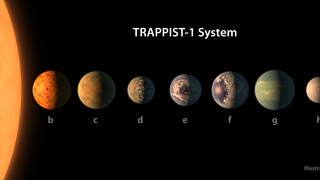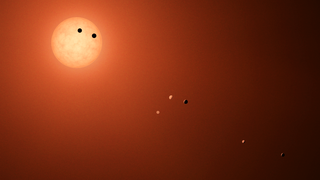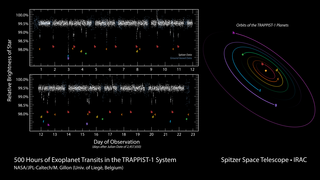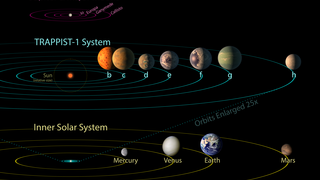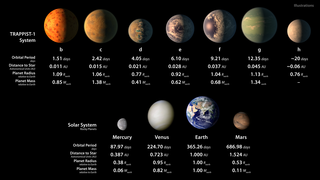Planets and Moons
Universe
ID: 30871
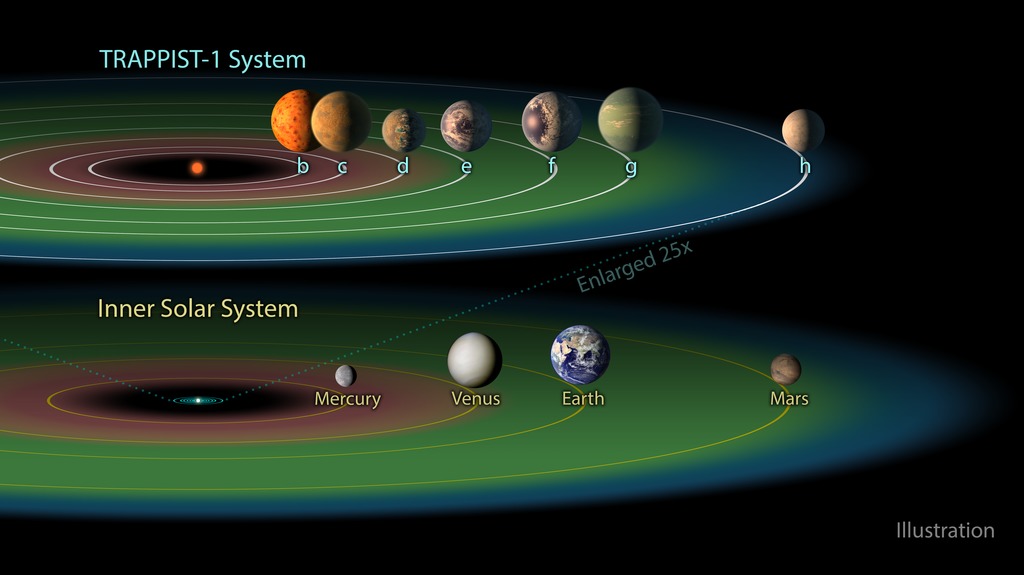
The TRAPPIST-1 system contains a total of seven planets, all around the size of Earth. Three of them -- TRAPPIST-1e, f and g -- dwell in their star’s so-called “habitable zone.” The habitable zone, or Goldilocks zone, is a band around every star (shown here in green) where astronomers have calculated that temperatures are just right -- not too hot, not too cold -- for liquid water to pool on the surface of an Earth-like world.
While TRAPPIST-1b, c and d are too close to be in the system’s likely habitable zone, and TRAPPIST-1h is too far away, the planets’ discoverers say more optimistic scenarios could allow any or all of the planets to harbor liquid water. In particular, the strikingly small orbits of these worlds make it likely that most, if not all of them, perpetually show the same face to their star, the way our moon always shows the same face to the Earth. This would result in an extreme range of temperatures from the day to night sides, allowing for situations not factored into the traditional habitable zone definition. The illustrations shown for the various planets depict a range of possible scenarios of what they could look like.
The system has been revealed through observations from NASA's Spitzer Space Telescope and the ground-based TRAPPIST (TRAnsiting Planets and PlanetesImals Small Telescope) telescope, as well as other ground-based observatories. The system was named for the TRAPPIST telescope.
TRAPPIST-1 Exoplanets and the Habitable Zone

While TRAPPIST-1b, c and d are too close to be in the system’s likely habitable zone, and TRAPPIST-1h is too far away, the planets’ discoverers say more optimistic scenarios could allow any or all of the planets to harbor liquid water. In particular, the strikingly small orbits of these worlds make it likely that most, if not all of them, perpetually show the same face to their star, the way our moon always shows the same face to the Earth. This would result in an extreme range of temperatures from the day to night sides, allowing for situations not factored into the traditional habitable zone definition. The illustrations shown for the various planets depict a range of possible scenarios of what they could look like.
The system has been revealed through observations from NASA's Spitzer Space Telescope and the ground-based TRAPPIST (TRAnsiting Planets and PlanetesImals Small Telescope) telescope, as well as other ground-based observatories. The system was named for the TRAPPIST telescope.
Related
For More Information
Credits
Amy Moran (Global Science and Technology, Inc.): Project Support
Please give credit for this item to:
NASA/JPL-Caltech
NASA/JPL-Caltech
Short URL to share this page:
https://svs.gsfc.nasa.gov/30871
Keywords:
SVS >> Hyperwall
NASA Science >> Planets and Moons
NASA Science >> Universe
https://svs.gsfc.nasa.gov/30871
Keywords:
SVS >> Hyperwall
NASA Science >> Planets and Moons
NASA Science >> Universe
